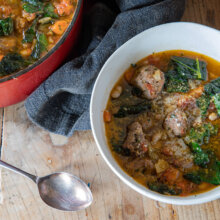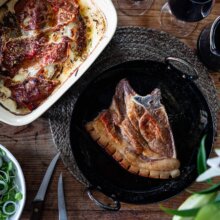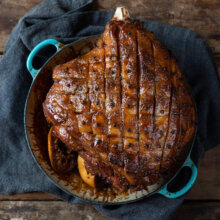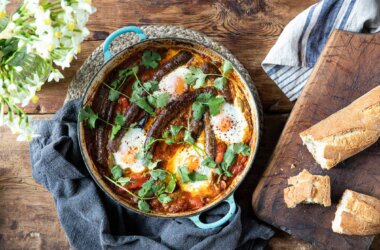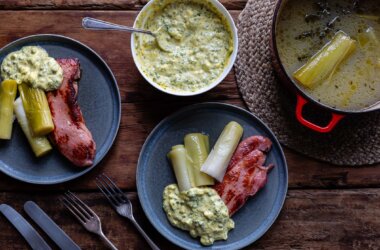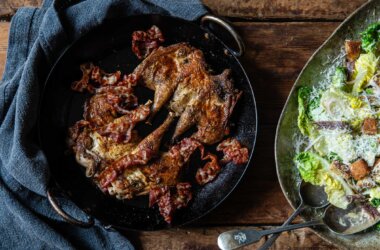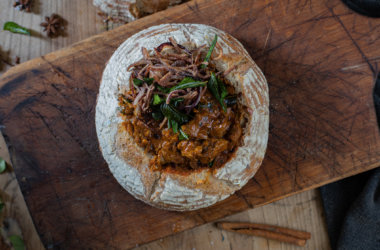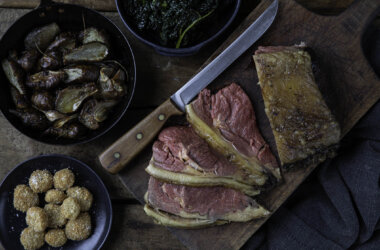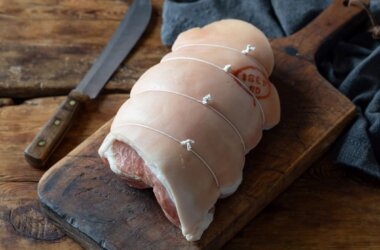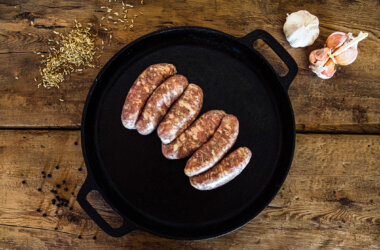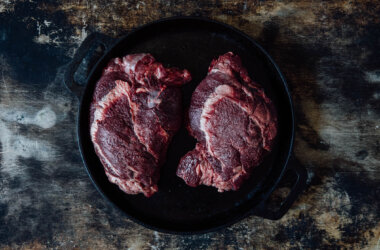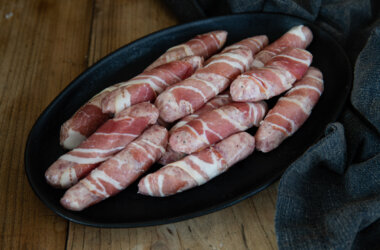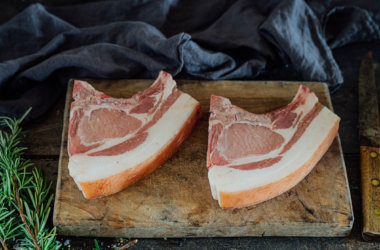It’s a testament to the pioneering folk at Swaledale Butchers that a cut probably more often found in the hands of a chef could make its way onto your dining table. But don’t let that dissuade you. Take it with confidence and cook something special.
A saddle of Venison is a beautiful thing to cook. The loin meat is both tender and rich and is protected during the roasting process by a layer of fat. With careful and considered cooking, you should achieve a perfect medium-rare finish, a rich red, all the way through the joint — it is sure to wow!
These red wine braised are a classic and a great recipe to have up your sleeve as they go so well with many a cut of meat. And, of course, we must not forget the braised radicchio. If you have never tried it before, then prepare to feel enlightened. It’s an eye-opener that makes you jealous of the good people of Northern Italy, who have been feasting on the stuff for generations.

Serves 6-8
Ingredients
For the lentils
For the braised radicchio
Sauce
Method
- You want to start by getting the Venison saddle out of the fridge and out of the packaging. Leave it to one side to warm to room temperature — this will result in a much more even cook.
- Preheat the oven to 160°C.
For the sauce:
- Tip the bones into a roasting tray and roast in the oven for 30 minutes.
- Meanwhile, take a large pan and add 2 tablespoons of olive oil, and begin to sweat off the onions, carrots, juniper, and garlic. Cook them on a medium heat, with a lid on but stirring regularly for about 20 minutes until all the vegetables are really soft and sweet.
- Carefully tip the roasted bones into the pot with the vegetables. Then de-glaze the roasting tray with the red wine. Tip the red wine in with the vegetables and bones and bring to a boil.
- Once boiling, add the stock and herbs. Return to a boil, then reduce the heat to a simmer and cook for about 1 hour.
- After an hour, take the pot off the heat and let it sit for 20 minutes or so. Then pass through a fine sieve. Discard the bones and vegetables and return the liquid to the heat. Simmer for a further 45 minutes to an hour — or until you have the desired consistency.
- Check for seasoning and adjust if necessary.
For the lentils:
- Take a large, heavy-bottomed pan, place on medium heat with 2 tablespoons of olive oil, and add the lardons. Stirring regularly, let them brown whilst also rendering out their fat. Once browned and swimming in lovely fat, add the onions, carrots, garlic, celery, celeriac, and a good pinch of salt. Cook this with a lid on, over allow heat for about 20 minutes, stirring frequently. You want the veg to be really soft and just beginning to colour a little, at which point add the lentils and the red wine.
- Bring the wine to the boil and then simmer for a couple of minutes before adding the chicken stock, herbs, and 3 more tablespoons of extra virgin olive oil, plus another pinch of salt. Allow this to come up to the boil and then reduce to a simmer. Cover with a lid and simmer for about 45 minutes, stirring occasionally. If at any point it is looking a bit dry, then add a dribble more chicken stock.
Back to the venison:
- Season the venison well with salt. Find a pan that is big enough to brown it off and set it over a high heat. Once hot, add the venison and reduce the heat to medium. Colour off on all sides, rotating it every minute or so. If the pan is too hot, turn the heat down. You want to colour the fat but also render out some of the fat, so a fierce heat is not desirable. Once the whole joint is browned, add the knob of butter and baste the meat. Then transfer it to the oven, either in the pan you have browned it in or on an oven tray. Set a timer for 12 minutes.
- Check the lentils I personally don’t like my lentils al dente (although some people do, apparently), they should be soft and almost creamy, but importantly, not complete mush. Check the seasoning and adjust if necessary – I find a good splash of sherry (or any other good vinegar) is what’s needed.
- When the timer goes off for the venison, remove it from the oven and carefully baste the joint, and then rotate it so that the side that was against the pan is now facing upwards. Baste it again and return to the oven for another 12 minutes.
- Meanwhile, quarter the radicchio and wash it well. In a large frying pan, add 3 tablespoons of extra virgin olive oil and the garlic cloves, gently crushed with the back of a knife. Cook on a high heat for 30 seconds, just to begin to release the aroma of the garlic. Then add the radicchio and a good pinch of salt and cook on a high heat, stirring frequently. Keep cooking it for about 10 minutes (turning the heat down if it gets too intense). Then add the vinegar and the picked thyme, stir and check the seasoning. Adjust if necessary.
- After 12 minutes, remove the venison from the oven and baste again. Then give the meat a test by inserting a small knife into the centre of the joint and then removing it and placing it, with care, on your lip. The knife should be warm, just above body temperature, ready for a nice long rest, at least 30 minutes, in a warm place. If it is still cold when pressed against your lip, return it to the oven and cook in 4 minute segments until the knife is warm. The joint will need to rest, once cooked, for at least 30 minutes.
- Take the pickled walnuts and slice them into little ‘coins’. Re-heat the sauce and drop in the pickled walnuts and a little splash of their pickling liquor. Pour plenty of this over each plate you serve.
